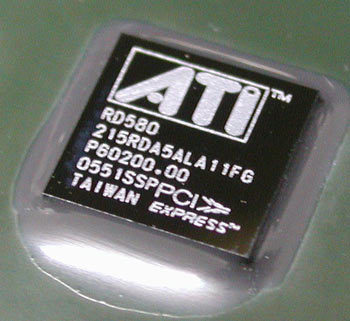ATI's Crossfire Xpress 3200 Chipset Takes Off
Crossfire Xpress 3200 Challenges nForce4 SLI X16
Today ATI releases its next generation dual graphics PCI Express chipset for Athlon 64 systems. The product is no longer called Radeon Xpress, but rather the Crossfire Xpress 3200. This change emphasizes its dual graphics capabilities, which are considered the key to the mainstream and high-end platform business today. True PCI Express dual x16 faces off against Nvidia's split lane solution, while a mediocre south bridge has to hold up against Nvidia's feature wealth.
The history of ATI and Nvidia battling for market share is roughly as old as that of mainstream 3D graphics, but the battlefield is no longer limited to 3D graphics alone. Both companies realize that their reputations translate perfectly into advantages in other areas, such as the core logic business. Hand in hand with this goes the increasing trend towards parallelization - processors go multi core, and two or more graphics chips are teamed up to share 3D workload. What could be better than a platform solution that even helps to increase graphics sales? Ready or not, dual graphics is here.
If all that you need is an ordinary computer, any of the current core logic products from ATI, Nvidia, SiS or VIA will be adequate. But since you are reading this article, we think you are likely interested in high-performance graphics platforms, which is what ATI and Nvidia emphasize. Unfortunately, Crossfire and SLI "certification" prevents other chipset vendors from playing the graphics game. You need an Nvidia platform if you want GeForce 7 dual graphics, and ideally an ATI platform for Radeon X1000 solutions. While there are a few chipset alternatives to power ATI dual graphics, GeForce twin setups will only run on Nvidia nForce products.
However, both ATI and Nvidia also realize that core logic products depend on their value proposition in order to sell well. Nvidia was quick to implement appealing features such as a Gigabit Ethernet controller with added hardware firewall, and adding sophisticated software that isn't available from the competition. Since the Santa Clara based firm also entered the chipset market earlier, it is not surprising that the nForce4 family is still our Athlon chipset of choice. ATI knew it had to close the gap, which is why it intended to purchase the Taiwanese chipset maker ULi. But the deal did not work out, probably because Nvidia was more aggressive once again and made the better offer.
Despite this turbulent history, the Crossfire Xpress 3200 chipset is finally here - and it is on the way to claiming the dual graphics chipset crown. Let's find out if it indeed represents a changing of the guard.
Get Tom's Hardware's best news and in-depth reviews, straight to your inbox.
Current page: Crossfire Xpress 3200 Challenges nForce4 SLI X16
Next Page Crossfire Xpress 3200 Features
Patrick Schmid was the editor-in-chief for Tom's Hardware from 2005 to 2006. He wrote numerous articles on a wide range of hardware topics, including storage, CPUs, and system builds.
